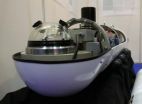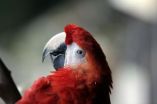(Press-News.org) Even when equipped with compressed-air bottles and diving regulators, humans reach their limits very quickly under water. In contrast, unmanned submarine vehicles that are connected by cable to the control center permit long and deep dives. Today remote-controlled diving robots are used for research, inspection and maintenance work. The possible applications of this technology are limited, however, by the length of the cable and the instinct of the navigator. No wonder that researchers are working on autonomous underwater robots which orient themselves under water and carry out jobs without any help from humans.
In the meantime, there are AUVs (autonomous underwater vehicles) which collect data independently or take samples before they return to the starting points. "For the time being, the technology is too expensive to carry out routine work, such as inspections of bulkheads, dams or ships' bellies," explains Dr. Thomas Rauschenbach, Director of the Application Center System Technology AST Ilmenau, Germany at the Fraunhofer Institute for Optronics, System Technologies and Image Exploitation IOSB. This may change soon. Together with the researchers at four Fraunhofer Institutes, Rauschenbach's team is presently working on a generation of autonomous underwater robots which will be smaller, more robust and cheaper than the previous models. The AUVs shall be able to find their bearings in clear mountain reservoirs equally well as in turbid harbor water. They will be suitable for work on the floor of the deep sea as well as for inspections of shallow concrete bases that offshore wind power station have been mounted on.
The engineers from Fraunhofer Institute for Optronics, System Technologies and Image Exploitation in Karlsruhe, Germany are working on the "eyes" for underwater robots. Optical perception is based on a special exposure and analysis technology which even permits orientation in turbid water as well. First of all, it determines the distance to the object, and then the camera emits a laser impulse which is reflected by the object, such as a wall. Microseconds before the reflected light flash arrives, the camera opens the aperture and the sensors capture the incident light pulses. At the Ilmenau branch of the Fraunhofer Institute for Optronics, System Technologies and Image Exploitation, Rauschenbach's team is developing the "brain" of the robot: a control program that keeps the AUV on course in currents such as at a certain distance to the wall that is to be examined. The Fraunhofer Institute for Biomedical Engineering IBMT in St. Ingbert provides the silicone encapsulation for the pressure-tolerant construction of electronic circuits as well as the "ears" of the new robot: ultrasound sensors permit the inspection of objects. Contrary to the previously conventional sonar technology, researchers are now using high-frequency sound waves which are reflected by the obstacles and registered by the sensor. The powerful but lightweight lithium batteries of the Fraunhofer ISIT in Itzehoe that supply the AUV with energy are encapsulated by silicone. A special energy management system that researchers at the Fraunhofer Institute for Environmental, Safety and Energy Technology UMSICHT in Oberhausen, Germany have developed saves power and ensures that the data are saved in emergencies before the robot runs out of energy and has to surface.
A torpedo-shaped prototype two meters long that is equipped with eyes, ears, a brain, a motor and batteries will go on its maiden voyage this year in a new tank in Ilmenau. The tank is only three meters deep, but "that's enough to test the decisive functions," affirms Dr. Rauschenbach. In autumn 2011, the autonomous diving robot will put to sea for the first time from the research vessel POSEIDON: Several dives up to a depth of 6,000 meters have been planned.
INFORMATION:
Underwater robots on course to the deep sea
2010-11-24
ELSE PRESS RELEASES FROM THIS DATE:
LSU sociologist produces documentary on Kenyan election violence
2010-11-24
While Africa is certainly no stranger to violence, the response to the Kenyan presidential elections of 2007 came as a surprise. Political unrest evolved into outright and unmitigated violence, marring the relatively peaceful history of Kenya's educated and mainly urban population. During allegations of voter manipulation and election fraud, two of Kenya's largest tribes, the Kalenjin and the Kikuyu, found themselves divided by anger, fueled by another tribe's promises of power and control.
Wesley Shrum, LSU professor of sociology, had experience dealing with human tragedy ...
ISU researcher, collaborators, re-sequence 6 corn varieties, find some genes missing
2010-11-24
AMES, Iowa - Most living plant and animal species have a certain, relatively small, amount of variation in their genetic make-up.
Differences in height, skin and eye color of humans, for example, are very noticeable, but are actually the consequences of very small variations in genetic makeup.
Researchers at Iowa State University, China Agricultural University and the Beijing Genomics Institute in China recently re-sequenced and compared six elite inbred corn (maize) lines, including the parents of the most productive commercial hybrids in China.
When comparing the different ...
Monitoring wear in helicopters -- and hips, knees and ankles, too
2010-11-24
Tel Aviv -- Ferrography, a practice used by the American and Israeli air forces to monitor the condition of machinery, extracts tiny iron particles from lubricants such as oil and grease to analyze wear in machines. Determining whether a system requires preventative maintenance can be the key to preventing catastrophic failure.
Now Tel Aviv University scientists are exploring a modification of this technique for human analysis -- called "bio-ferrography" -- to diagnose diseases in their early stages, determine the efficacy of drugs, and ascertain the condition of orthopedic ...
75 percent of Spanish zoos at risk of exotic animals escaping
2010-11-24
Lions, bears, monkeys, crocodiles, parrots and iguanas may seem inoffensive at first glance when they're behind bars in zoos. But some exotic species can escape and become invasive species. This has been confirmed by a scientific team that has checked 1,568 animal houses in 63 Spanish zoos. Birds are the animals most likely to escape.
"As zoos house a large number of exotic (non-indigenous) species, they could become an entry channel for these species if they escape, with the potential environmental risk that this implies", María C. Fàbregas, lead author of the study ...
BUSM investigates cellular mechanisms leading to immune response in airway epithelium
2010-11-24
(Boston) – Researchers from the Boston University School of Medicine (BUSM) have demonstrated that commensal species of the genus Neisseriae are low inducers of human airway epithelial cell responses as compared to the pathogenic species. Specifically, the study indicates that a Neisserial outer membrane component appears to play a differential role in the host inflammatory responses via interaction with a receptor on the surface of human airway epithelial cells.
Paola Massari, an assistant professor in the section of infectious diseases at BUSM, is lead author of this ...
CCNY chemists design molecule that responds to stimuli
2010-11-24
The venus flytrap plant captures its prey when it senses the presence of an insect on the tips of its leaves. An amphiphilic molecule designed by chemists at The City College of New York acts in a similar manner by changing its structure when heated slightly and, then, reverting to its original form when cooled.
The finding, reported in the journal Angewandte Chemie, points toward the possibility of designing adaptive soft materials in the lab that take their cues from how nature responds to stimuli, said Dr. George John, associate professor and corresponding author.
Professor ...
Alcohol consumption decreases with the development of disease
2010-11-24
In a cross-sectional study from the 2004 and 2007 Australian National Drug Strategy Household (NDSH) surveys, respondents were questioned about their current and past drinking, the presence of formal diagnosis for specific diseases (heart disease, type 2 diabetes, hypertension, cancer, anxiety, depression) and self-perceived general health status. The sample sizes for the 2004 and 2007 NDSH surveys were 24,109 and 23,356, respectively.
The authors report that respondents with a diagnosis of diabetes, hypertension, or anxiety were more likely to have reduced or stopped ...
Plant-derived scavengers prowl the body for nerve toxins
2010-11-24
The brain is forever chattering to itself, via electrical impulses sent along its hard-wired neuronal "Ethernet." These e-messages are translated into chemical transmissions, allowing communication across the narrow cleft separating one neuron from another or between neurons and their target cells. Of the many kinds of molecules involved in this lively chemical symposium, acetylcholine is among the most critical, performing a host of functions in the central and peripheral nervous system. This delicate cholinergic design however is highly vulnerable. It can fall victim ...
Shrubby crops can help fuel Africa's green revolution
2010-11-24
EAST LANSING, Mich. — Crop diversification with shrubby legumes mixed with soybean and peanuts could be the key to sustaining the green revolution in Africa, according to a Michigan State University study.
The study, which appears in the Nov. 22 issue of the Proceedings of the National Academy of Sciences, states that diversifying crops would boost production of nutrient-enriched grain by 12 percent to 23 percent, said Sieglinde Snapp, a crop and soil scientist at Michigan State University's Kellogg Biological Station.
Malawi has been called the cradle of Africa's green ...
ORNL scientists crack materials mystery in vanadium dioxide
2010-11-24
OAK RIDGE, Tenn., Nov. 23, 2010 -- A systematic study of phase changes in vanadium dioxide has solved a mystery that has puzzled scientists for decades, according to researchers at the Department of Energy's Oak Ridge National Laboratory.
Scientists have known that vanadium dioxide exhibits several competing phases when it acts as an insulator at lower temperatures. However, the exact nature of the phase behavior has not been understood since research began on vanadium dioxide in the early 1960s.
Alexander Tselev, a research associate from the University of Tennessee-Knoxville ...




